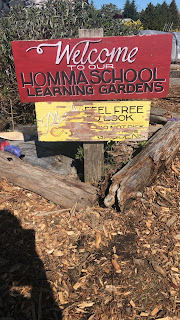The group of Morris dancers joined us soon after we were clothed in the vibrant cloth. Breaking into three groups of three, we were lead through the dance "Tinner's Rabbit" by the pair of fantastic accordion players in our midst. This dance revolved around participants skipping to the beat in circles, interweaving with each other, and performing what is called the stick chorus by beating their sticks against each other's in rhythmic intervals. The dance was lively, and the song that we learned following the dance was equally entertaining.
The implications of this event to our educational practices are many. First, the tradition known as Morris dancing is a perfect way to bridge the gap between outdoor education and history courses or social studies. Aside from being fun to perform, the respectful approach to learning about historical traditions is a skill that many students never have a chance to practice, as exposure to traditions outside of one's own in the traditional school system tends to be low. Allowing children to come to their own conclusions about different traditions by participating in them themselves is a valuable learning experience, and one that most students will never forget.
The second implication is that the act of performing a task can lead to further growth of students. For math specifically, Morris dancing combines geometrical shapes with concepts of rhythm, beat, and measure, bringing math, music, and English together in a way not commonly seen. The interdisciplinary discussions that arise from practicing these traditional dances may allow students to see the interactions between their different subjects in day-to-day life, even back in the fifteenth century. Helping students think of learning as a process, furthered by the acquisition of knowledge in any realm of study, may allow them to become more well-rounded students. Overall, the Morris dancing was incredibly enjoyable, and I would recommend that everyone take time to attempt it at least once.
 |
| So many geese. They seemed to enjoy the music. |
 |
| Adorning the students with colorful hats. |
 |
| CFE students, ready to learn the "Tinner's Rabbit" |

































